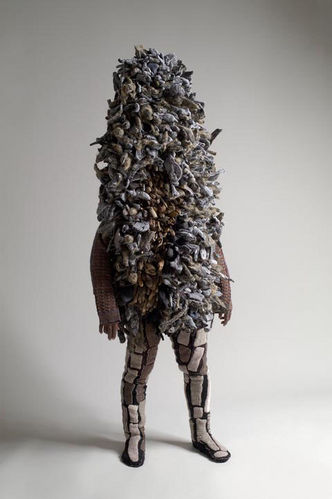Nick Cave's Soundsuits
 Nick Cave, Soundsuit 1, socks, paint, dryer lint, wood, wool, 2006
Nick Cave, Soundsuit 1, socks, paint, dryer lint, wood, wool, 2006
Nick Cave, not the singer, but the artist from Missouri who was with Alvin Ailey American Dance Theater and is now director of the fashion program at the Art Institute of Chicago. Above, is a Soundsuit. Soundsuits' references are wide and deep, they are sculptures, costumes, installations. They are assemblages, they make sounds, they refer historically to various African ceremonial garments. They appear in performances and in art museums.
I lived in the middle of Kansas for a year, my first teaching gig, and spent a lot of time driving back country roads and finding installations of what was known as folk art then, outsider art now. What they all had in common is their obsessive convictions and their marginal relationship to orthodox art and architecture – the Watts Towers in Los Angeles were not unlike Gaudi's Sagrada Familia in their mad-builder concentration.
More recently, Tyree Guyton's Heidelberg project in Detroit has rejuvenated a despairing neighbourhood by saying, your house is yours, make it into something that is you. And because this is an economically challenged place, such transformations inevitably are done with discarded and then re-found materials: the essence of folk art: all invention, no money.
What is interesting about this and where it comes back to Nick Cave and Soundsuits is that these projects cannot be included under the patronising rubric of outsider art: Nick Cave is firmly in the centre of American art production, and Heidelberg is a well-documented demonstration project of urban renewal that does not involve mass destruction.
Last week Gloria Steinem in an interview on Q said it takes about a hundred years for a social change to really become an embedded part of the social fabric. Second wave feminism is about 40 years old and so, no, we are not in a post-feminist era, we still have 60 years of feminist struggle ahead. The civil rights movement in the USA happened in the 1960s, just 50 years ago. We are only now starting to find work that is embedded in the orthodoxy of contemporary art discourse: it is not post-racial, for it is so very African American, an identity that is critical to the work. But it is allowed to take its place within the discourse, and that is new.
